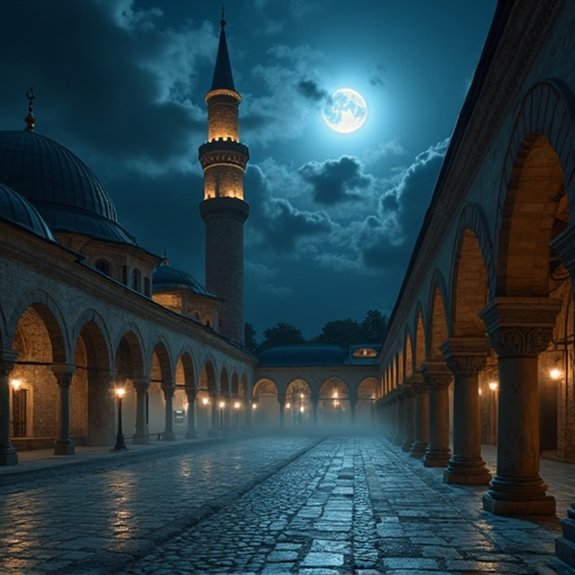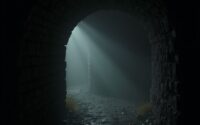Spirits of Sultans: Haunted Mosques
Istanbul’s ancient mosques harbor more than prayer halls and minarets. Visitors report unexplained footsteps echoing through the Süleymaniye at dusk, while guards at the Blue Mosque won’t discuss what they’ve witnessed after midnight. These Ottoman burial sites, where sultans rest in ornate türbes, attract both historians and paranormal investigators. The connection between royal tombs and supernatural activity isn’t coincidental—it’s rooted in centuries-old burial practices that blur boundaries between sacred and spectral.
Introduction

When twilight shadows stretch across ancient minarets and prayer halls fall silent, stories emerge of sultans whose spirits haven’t found peace within the sacred walls they once ruled. These haunted mosques stand as symbols of power, tragedy, and unfinished business from centuries past. From Istanbul’s grand complexes to Cairo’s medieval quarters, locals whisper about phantom footsteps echoing through empty corridors and mysterious lights flickering in abandoned chambers.
Historians can’t explain why certain mosques attract supernatural claims while others don’t. Perhaps it’s the violent deaths, broken oaths, or unfulfilled vows that anchor these royal spirits to their former domains. Whatever the cause, these sites blend religious reverence with spectral intrigue, drawing believers, skeptics, and paranormal investigators who seek evidence of sultans refusing to relinquish their earthly thrones.
Ancient Ottoman Burial Practices
Though Islamic tradition calls for simple burials, Ottoman sultans developed elaborate funeral rites that merged religious requirements with imperial grandeur. They’d wash the body with rose water and camphor, wrap it in fine white shrouds, then place it in ornate wooden coffins draped with precious fabrics. The funeral procession moved through Constantinople’s streets as mourners recited prayers and scattered coins to the poor.
Sultans weren’t buried in ordinary cemeteries. Instead, they’d rest in specially constructed türbes—domed mausoleums adjacent to mosques they’d commissioned. These octagonal structures featured intricate tilework, marble columns, and stained-glass windows. Multiple family members often shared these spaces, with the sultan’s coffin elevated on a platform while wives and children occupied surrounding positions, creating dense concentrations of royal remains.
Notable Cases or Sightings

The Süleymaniye Mosque’s night guards have reported footsteps echoing through empty prayer halls long after closing, always moving toward Sultan Süleyman’s türbe. They’ve documented cold spots near the tomb entrance and witnessed prayer rugs shifting without wind or human touch.
Istanbul’s Blue Mosque has generated similar accounts. Visitors have photographed unexplained orbs floating above Ahmed I’s burial chamber. Local imams won’t discuss the white-robed figure seen kneeling in prayer before dawn, though multiple witnesses have described identical sightings.
At Bursa’s Green Mosque, custodians report doors opening themselves and the scent of rose water materializing near Mehmed I’s sarcophagus. Security footage from 2019 captured a translucent form gliding through locked gates. These encounters typically increase during Ramadan, when spiritual activity allegedly intensifies throughout Turkey’s historic mosques.
Common Theories or Explanations
While skeptics attribute these phenomena to structural settling and acoustic tricks common in centuries-old buildings, believers offer supernatural explanations rooted in Islamic mysticism. They suggest that jinn, supernatural beings mentioned in the Quran, inhabit these sacred spaces. Some scholars propose that powerful spiritual energy from centuries of prayer has created residual imprints that manifest as apparitions.
Parapsychologists point to electromagnetic fields generated by underground water channels beneath many mosques. These fields allegedly trigger hallucinations and feelings of being watched. Others cite sleep deprivation during night prayers as causing hypnagogic experiences. Cultural anthropologists argue that shared folklore creates collective psychological expectations, making visitors more susceptible to interpreting ambiguous stimuli as paranormal. Temperature fluctuations in marble halls produce sounds easily mistaken for footsteps or whispers.
Frequently Asked Questions
Can Tourists Visit These Haunted Mosques During Regular Prayer Times?
Tourists can’t visit mosques during prayer times as worshippers need privacy for religious observance. They’re welcome during designated visiting hours between prayers, though some mosques restrict non-Muslim access to certain areas year-round regardless of timing.
What Safety Precautions Should Visitors Take When Exploring These Sites?
Visitors should dress modestly, remove shoes before entering, and respect prayer areas. They’ll need to stay with guided groups, avoid photographing worshippers, and shouldn’t touch religious artifacts. Local guides can explain specific cultural protocols.
Are There Specific Months When Paranormal Activity Increases?
Paranormal investigators report heightened activity during Muharram and Ramadan, when spiritual veils supposedly thin. They’ve documented increased sightings during lunar eclipses and the 27th night of Rajab, when sultans’ spirits allegedly walk mosque corridors most frequently.
Do Local Religious Authorities Acknowledge These Supernatural Claims?
Religious authorities typically don’t officially acknowledge supernatural claims about haunted mosques. They’ll often attribute unexplained phenomena to natural causes or dismiss them as superstition, though some clerics privately admit experiencing strange occurrences they can’t explain.
Which Haunted Mosques Offer Guided Night Tours?
Most mosques don’t offer official guided night tours focused on paranormal activity, though Istanbul’s Sultanahmet and Cairo’s Ibn Tulun occasionally permit supervised evening visits. Informal guides sometimes lead unofficial ghost tours around mosque perimeters after hours.


